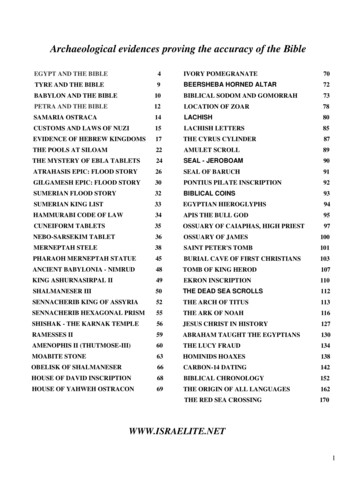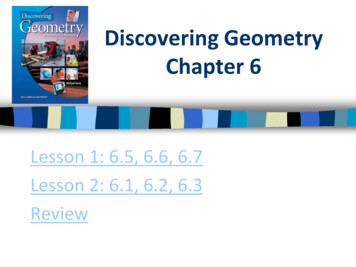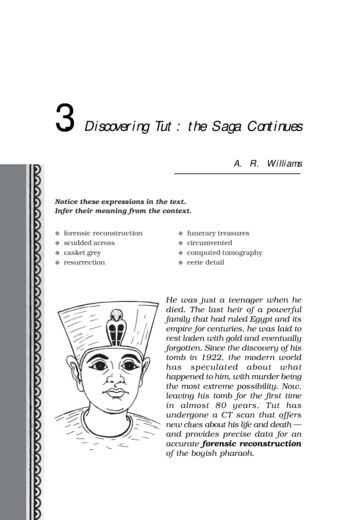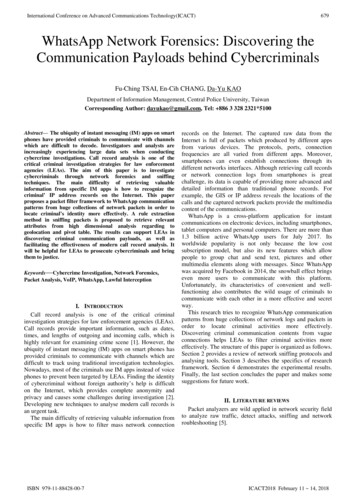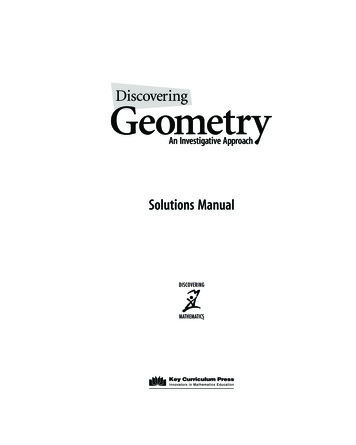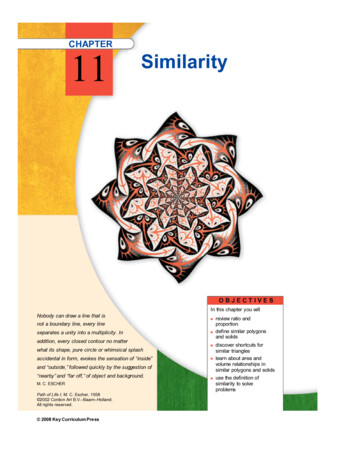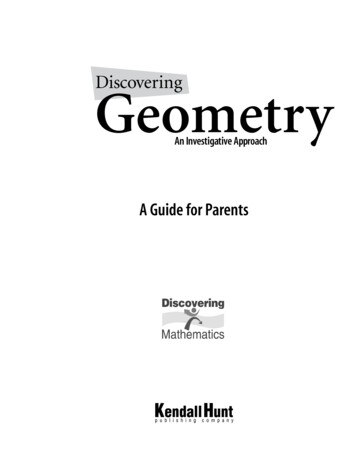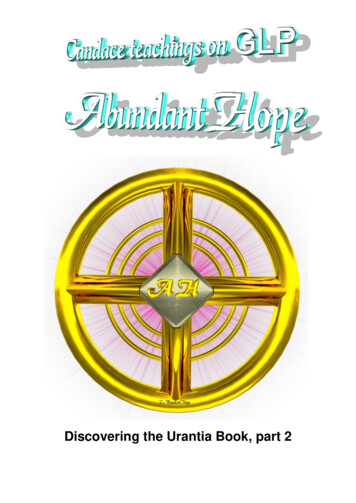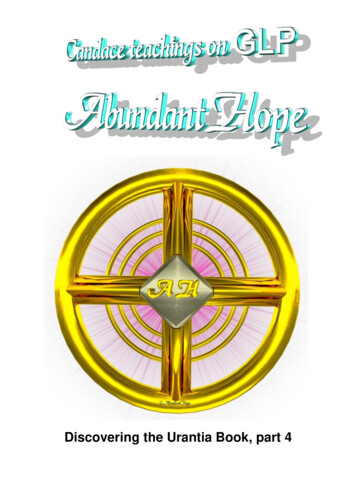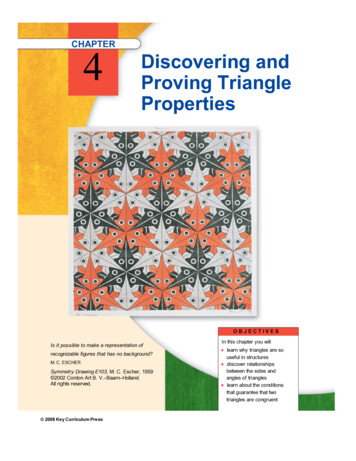
Transcription
hapter 4 Page rtingCourses/DG4E/.CHAPTER4Discovering andProving TrianglePropertiesOBJECTIVESIs it possible to make a representation ofrecognizable figures that has no background?M. C. ESCHERSymmetry Drawing E103, M. C. Escher, 1959 2002 Cordon Art B. V.–Baarn–Holland.All rights reserved. 2008 Key Curriculum PressIn this chapter you willlearn why triangles are souseful in structuresdiscover relationshipsbetween the sides andangles of triangleslearn about the conditionsthat guarantee that twotriangles are congruent
ewer/Lesson.htmL E S S O N4.1Triangle Sum ConjectureTriangles have certain properties thatTeaching is the art ofassisting discovery.ALBERT VAN DORENmake them useful in all kinds ofstructures, from bridges to high-risebuildings. One such property oftriangles is their rigidity. If you buildshelves like the first set shown at right,they will sway. But if you nail anotherboard at the diagonal as in the secondset, creating a triangle, you will haverigid shelves.Another application of triangles is aprocedure used in surveying calledtriangulation. This procedure allows surveyors to locate points or positions on amap by measuring angles and distances and creating a network of triangles.Triangulation is based on an important property of plane geometry that you willdiscover in this lesson.The Triangle SumThere are an endless variety of triangles that you candraw, with different shapes and angle measures. Dotheir angle measures have anything in common? Startby drawing different kinds of triangles. Make sure yourgroup has at least one acute and one obtuse triangle.a protractora straightedgescissorspatty paper200Step 1Measure the three angles of each triangle asaccurately as possible with your protractor.Step 2Find the sum of the measures of the three angles ineach triangle. Compare results with othersin your group. Does everyone get aboutthe same result? What is it?Step 3Check the sum another way. Writethe letters a, b, and c in theinteriors of the three angles ofone of the triangles, andcarefully cut out the triangle.CHAPTER 4 Discovering and Proving Triangle Properties 2008 Key Curriculum Press
ewer/Lesson.htmStep 4Tear off the three angles. Arrange them so that their vertices meet at a point.How does this arrangement show the sum of the angle measures?Step 5Compare results with others in your group. State your observations as aconjecture.Triangle Sum ConjectureThe sum of the measures of the angles in every triangle is.Developing Proof The investigation may have convinced you that the Triangle SumConjecture is true, but can you explain why it is true for every triangle?As a group, explain why the Triangle Sum Conjecture is true by writing aparagraph proof, a deductive argument that uses written sentences to support itsclaims with reasons.Another reasoning strategy you might use is to add an auxiliary line, an extraline or segment that helps with a proof. Your group may have formed an auxiliaryline by rearranging the angles in the investigation. If you rotated A and B andleft C pointing up, then how is the resulting line related to the original triangle?Draw any ABC and draw in that auxiliary line.The figure at right includes EC, an auxiliary lineparallel to side AB. Use this diagram to discussthese questions with your group.What are you trying to prove?What is the relationship among 1, 2,and 3?Why was the auxiliary line drawn to be parallel to one of the sides?What other congruencies can you determine from the diagram?Use your responses to these questions to mark your diagram. Discuss how you canuse the information you have to prove that the Triangle Sum Conjecture is true forevery triangle. As a group, write a paragraph proof. When you are satisfied withyour group’s proof, compare it to the one presented on the next page. 2008 Key Curriculum PressLESSON 4.1 Triangle Sum Conjecture 201
ewer/Lesson.htmParagraph Proof: The Triangle Sum ConjectureConsider 1 and 2 together as a single angle that forms a linear pair withthe Linear Pair Conjecture, their measures must add up to 180 .3. Bym 1 m 2 m 3 180 AC and BC form transversals between parallel linesEC and AB . By the Alternate Interior AnglesConjecture, 1 and 4 are congruent and 3 and5 are congruent, so their measures are equal.m 1 m 4m 3 m 5Substitute m4 for m1, and m5 for m3 in the first equation above.m 4 m 2 m 5 180 Therefore, the measures of the angles in a triangle add up to 180 .So far, you have been writing deductive arguments to explain why conjectures aretrue. The paragraph proof format puts a little more emphasis on justifying yourreasons. You will also learn about another proof format later in this chapter.If you have two angles of a triangle, you can use the Triangle Sum Conjecture toconstruct the third angle. This example shows one way to do this.EXAMPLESolution202Given A and N, constructangle of AND.D, the thirdLabel A and N as 1 and 2respectively. Draw a line. Duplicate 1opening to the left on this line. Duplicate2 opening to the right at the same vertexon this line. Because the measures of thethree angles add to 180 , the measure of3 is equal to that of D.CHAPTER 4 Discovering and Proving Triangle Properties 2008 Key Curriculum Press
ewer/Lesson.htmEXERCISESYou will need1. Technology Using geometry software, construct a triangle. Use the softwareto measure the three angles and calculate their sum. Drag the vertices anddescribe your observations.Use the Triangle Sum Conjecture to determine each lettered angle measure inExercises 2–5. You might find it helpful to copy the diagrams so you can write on them.2. x 3. v 4. z 5. w 6. Find the sum of themeasures of the markedangles.7. Find the sum of themeasures of the markedangles.8. a b c d e 2008 Key Curriculum Press9. m n p q r s t u LESSON 4.1 Triangle Sum Conjecture 203
ewer/Lesson.htmIn Exercises 10–12, use what you know to construct each figure. Use only a compass anda straightedge.10. Construction GivenA andR ofARM, construct11. Construction In LEG, m E m G. Givenconstruct G.12. Construction GivenA,M.L,R, and side, AE construct EAR.13. Construction Repeat Exercises 10–12 with patty-paperconstructions.14. Developing Proof In MAS below, M is a right angle.Let’s call the two acute angles, A and S, “wrong angles.”Write a paragraph proof or use algebra to show that“two wrongs make a right,” at least for angles in aright triangle.15. Developing Proof In your own words, prove the Triangle Sum Conjecture. Whatconjectures must we accept as true in order to prove it?16. Use your ruler and protractor to draw PDQ if m P 40 , m Q 55 , andPD 7 cm. How can the Triangle Sum Conjecture make this easier to do?17. Mini-Investigation Suppose two angles of one triangle have the same measures astwo angles of another triangle. What can you conclude about the third pair ofangles?Draw a triangle on your notebook paper. Create a second triangle on patty paperby tracing two of the angles of your original triangle, but make the side betweenyour new angles longer than the corresponding side in the original triangle. Howdo the third angles in the two triangles compare?Conjecture: If two angles of one triangle are equal in measure to two anglesof another triangle, then the third angles of the triangles . (Third AngleConjecture)204CHAPTER 4 Discovering and Proving Triangle Properties 2008 Key Curriculum Press
ewer/Lesson.htm18. Developing Proof Use the Triangle Sum Conjecture and the figures at rightto write a paragraph proof explaining why the Third Angle Conjectureis true.19. Developing Proof Write a paragraph proof, or use algebra, to explain whyeach angle of an equiangular triangle measures 60 .ReviewIn Exercises 20–24, tell whether the statement is true or false. For eachfalse statement, explain why it is false or sketch a counterexample.20. If two sides in one triangle are congruent to two sides in another triangle, then thetwo triangles are congruent.21. If two angles in one triangle are congruent to two angles in another triangle, thenthe two triangles are congruent.22. If a side and an angle in one triangle are congruent to a side and an angle inanother triangle, then the two triangles are congruent.23. If three angles in one triangle are congruent to three angles in anothertriangle, then the two triangles are congruent.24. If three sides in one triangle are congruent to three sides inanother triangle, then the two triangles are congruent.25. What is the number of stories in the tallest houseyou can build with two 52-card decks?How many cards would it take?Dissecting a Hexagon ITrace this regular hexagon twice.1. Divide one hexagon into four congruent trapezoids.2. Divide the other hexagon into eight congruent parts.What shape is each part? 2008 Key Curriculum PressLESSON 4.1 Triangle Sum Conjecture 205
ewer/Lesson.htmL E S S O N4.2Properties of IsoscelesTrianglesRecall from Chapter 1 that an isosceles triangleImagination is built uponknowledge.ELIZABETH STUART PHELPSis a triangle with at least twocongruent sides. In an isosceles triangle, the angle between the two congruentsides is called the vertex angle, and the other two angles are called the base angles.The side between the two base angles is called the base of the isosceles triangle.The other two sides are called the legs.In this lesson you’ll discover some properties of isosceles triangles.ArchitectureThe Rock and Roll Hall of Fame and Museum in Cleveland, Ohio, is a dynamicstructure. Its design reflects the innovative music that it honors. The front partof the museum is a large glass pyramid, divided into small triangular windows.The pyramid structure rests on a rectangular tower and a circular theaterthat looks like a performance drum. Architect I. M. Pei (b 1917) usedgeometric shapes to capture the resonance of rock and roll musical chords.206CHAPTER 4 Discovering and Proving Triangle Properties 2008 Key Curriculum Press
ewer/Lesson.htmBase Angles in an Isosceles TriangleLet’s examine the angles of an isosceles triangle. Each person in your group shoulddraw a different angle for this investigation. Your group should have at least oneacute angle and one obtuse angle.patty papera straightedgea protractorStep 1Draw an angle on patty paper. Label ityour isosceles triangle.C. This angle will be the vertex angle ofStep 2Place a point A on one ray. Fold your patty paper so that the two rays match up.Trace point A onto the other ray.Step 3Label the point on the other ray point B. Draw AB. You have constructed anisosceles triangle. Explain how you know it is isosceles. Name the base and thebase angles.Step 4Use your protractor to compare the measures of the base angles. Whatrelationship do you notice? How can you fold the paper to confirm yourconclusion?Step 5Compare results in your group. Was the relationship you noticed the same foreach isosceles triangle? State your observations as your next conjecture.Isosceles Triangle ConjectureIf a triangle is isosceles, then.Equilateral triangles have at least two congruent sides, so they fit the definition ofisosceles triangles. That means any properties you discover for isosceles triangleswill also apply to equilateral triangles. How does the Isosceles Triangle Conjectureapply to equilateral triangles?You can switch the “if” and “then” parts of the Isosceles Triangle Conjecture toobtain the converse of the conjecture. Is the converse of the Isosceles TriangleConjecture true? Let’s investigate. 2008 Key Curriculum PressLESSON 4.2 Properties of Isosceles Triangles 207
ewer/Lesson.htmIs the Converse True?Suppose a triangle has two congruent angles. Must the triangle be isosceles?a compassa straightedgeStep 1Draw a segment and label it AB. Draw an acute angleat point A. This angle will be a base angle. (Why can’tyou draw an obtuse angle as a base angle?)Step 2Copy A at point B on the same side of AB. Labelthe intersection of the two rays point C.Step 3Use your compass to compare the lengths of sides ACand BC. What relationship do you notice? How canyou use patty paper to confirm your conclusion?Step 4Compare results in your group. State your observationas your next conjecture.Converse of the Isosceles Triangle ConjectureIf a triangle has two congruent angles, then.EXERCISESYou will needFor Exercises 1–6, use your new conjectures to find the missing measures.1. m H 2082. m G CHAPTER 4 Discovering and Proving Triangle Properties3. m OLE 2008 Key Curriculum Press
ewer/Lesson.htm4. m R RM 5. m Y RD 6. The perimeter of MUDis 36.6 cm.m D m U MD 7. m T perimeter of8. The perimeter of NBCis 555 m.NB m N 9. The perimeter of MTVis 605 in.MV m M TBS10. Developing Proof Copy the figureat right. Calculate the measureof each lettered angle. Explainhow you determined themeasures d and h.11. The Islamic design below right is based on the star decagon construction shownbelow left. The ten angles surrounding the center are all congruent. Find the letteredangle measures. How many triangles are not isosceles? 2008 Key Curriculum PressLESSON 4.2 Properties of Isosceles Triangles 209
ewer/Lesson.htm12. Study the triangles in the software constructions below. Each triangle has one vertex atthe center of the circle, and two vertices on the circle.a. Are the triangles all isosceles?Write a paragraph proofexplaining why or why not.b. If the vertex at the center ofthe first circ
Technology Using geometry software, construct a triangle. Use the software to measure the three angles and calculate their sum. Drag the vertices and describe your observations. Use the Triangle Sum Conjecture to determine each lettered angle measure in Exercises 2–5. You might find it helpful to copy the diagrams so you can write on them.
